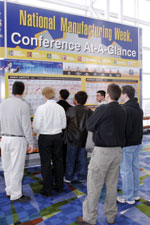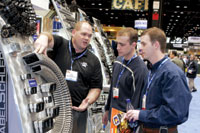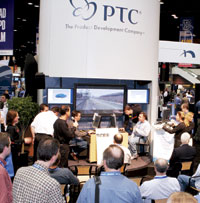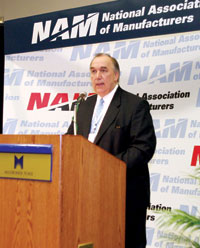
Slow show: Exhibitors observe declining attendance at NMW
May 17, 2005
By Nancy Kuyumcu
Despite efforts by show organizers to put a positive spin on attendance numbers, National Manufacturing Week (NMW) Exhibition and Conference is showing its age. Once the “granddaddy” of North American manufacturing trade shows, gathering the who’s who of the manufacturing world, NMW appears to be in decline. Some exhibitors say they’re not too happy with the dwindling attendance and are considering pulling out. Others have already voted with their feet.
 The 15th annual trade event, which took place at Chicago’s McCormick Place (March 7ᆞ) featured more exhibitors than last year-1,198 companies from 11 countries, compared to 1,055 exhibitors in 2004-but drew noticeably less visitors. Show organizers could not provide official visitor attendance at press time, but it was evident by slow booth traffic that visitor attendance was lacking.
The 15th annual trade event, which took place at Chicago’s McCormick Place (March 7ᆞ) featured more exhibitors than last year-1,198 companies from 11 countries, compared to 1,055 exhibitors in 2004-but drew noticeably less visitors. Show organizers could not provide official visitor attendance at press time, but it was evident by slow booth traffic that visitor attendance was lacking.
Still, organizers bill NMW as the largest North American manufacturing trade show covering all areas of manufacturing. The exhibition showcases the latest products and services available and provides an opportunity for manufacturers to meet new suppliers and hear from industry leaders and experts about key issues in manufacturing.
Many exhibitors who Manufacturing AUTOMATION met with commented on the low attendance numbers. “The quality of the people walking through [NMW] is an issue,” said James Bachle, electrical product manager, WAGO Corporation. “There aren’t enough buyers.” WAGO’s marketing promotions coordinator, Catherine Campbell, said that the company would likely not return next year.
 Jon Bach, vice-president, marketing, Carlo Gavazzi North America, had a similar point of view: “The show is not what it used to be,” he said. Carlo Gavazzi, which has exhibited at NMW for the past 10 years, will most likely exhibit again next year, but that’s partly because the company is based in nearby Buffalo Grove, Ill., according to Bach. “If we were from California, I’d have to think hard about it.”
Jon Bach, vice-president, marketing, Carlo Gavazzi North America, had a similar point of view: “The show is not what it used to be,” he said. Carlo Gavazzi, which has exhibited at NMW for the past 10 years, will most likely exhibit again next year, but that’s partly because the company is based in nearby Buffalo Grove, Ill., according to Bach. “If we were from California, I’d have to think hard about it.”
NMW attendee Robert Schowe, president, The Schowe Company, LLC, said the show was a “big disappointment” compared to the last show. “Last year, there was also a decline from the previous year, but since the economy rebounded, I thought [the show] would come back too, but I guess not.”
The show floor was delineated into eight pavilions: National Design Engineering; Micro Systems USA; National Plant Engineering and Facilities Management; Cleantech Cleaning Technology; Envirotech; National Industrial Automation; National Enterprise IT; and, for the first time, Aluminum USA.
The industrial automation pavilion included exhibitors such as WAGO Corporation, Advantech Corp. Industrial Automation Group, Mikron Infrared, Carlo Gavazzi, Lapp USA, National Instruments, Honeywell and Microsoft. Microsoft seemed to attract the largest crowds with its software and hardware prize giveaways.
 Next year, NMW will take place in Rosemont, Ill., at the Donald E. Stephens Convention Center (March 21ᆫ, 2006). The new venue is a five-minute drive from Chicago’s O’Hare Airport. Reed Exhibitions, the show’s organizers, say out-of-town guests will find the Rosemont venue more convenient because of its proximity to the airport, and that companies will find it cheaper to exhibit.
Next year, NMW will take place in Rosemont, Ill., at the Donald E. Stephens Convention Center (March 21ᆫ, 2006). The new venue is a five-minute drive from Chicago’s O’Hare Airport. Reed Exhibitions, the show’s organizers, say out-of-town guests will find the Rosemont venue more convenient because of its proximity to the airport, and that companies will find it cheaper to exhibit.
“[Our] independent research with exhibitors and attendees on a variety of topics relating to their participation in National Manufacturing Week [indicated] that both exhibitors and attendees alike wanted convenience, reasonable costs and a closer “community’ feel when participating in National Manufacturing Week,” said Kel Marsden-Kish, show director, Reed Exhibitions.
While some show-goers commented that the move to a smaller venue indicates that NMW is dying, other participants were optimistic about next year’s show.
“[The show] is smaller but better this year,” said show attendee Barry Van Name, principal, BVN Marketing Communication. Van Name’s firm represents several vendors that exhibited at the show. “My clients are already making plans to be back next year. I think this show will do very well at Rosemont.”
For more information, visit www.manufacturingweek.com.
Nancy Kuyumcu is the managing editor of Manufacturing AUTOMATION.
|
Attendance down across all industries
Dwindling trade show attendance is an issue in all industries, not just manufacturing. According to Starch Research Canada, in recent years the Internet gained significant ground as a vital and valued information source for purchasing decision-makers across all industries from manufacturing to retail. A 2000 Starch Research survey revealed that 53 percent of business decision-makers found the Internet to be “very useful” in making purchasing decisions, while 60 percent said trade shows were “very useful.” By 2004, trade shows’ “very useful” rating dropped to 56 percent, while the Internet’s rating remained steady at 53 percent. The opportunities the Internet offers also lead some vendors to stop exhibiting at trade shows. Some vendors find that well-designed websites, webinars, webcasts and e-mail offer a low-cost and convenient alternative to expensive trade shows when it comes to generating exposure and sales leads. |
The presenters
All but two keynote presentations at NMW attracted small numbers. Day one kicked off with a speech by Alain Belda, chief executive officer, Alcoa. In his keynote address, Belda told the fairly packed auditorium that North American manufacturers will continue to compete against cheap imports, and will have to be flexible enough to follow customers in the regions where they grow. “Speed, flexibility, market knowledge effective alliances and acquisitions, and innovation will be critical success factors required to win in an environment driven by these mega-trends,” said Belda.
Day two featured a panel discussion, “Manufacturing Town Hall,” which was also well-attended. The panel included John Engler, president, National Association of Manufacturers (NAM); Don Wainwright, chairman, U.S. Department of Commerce and Manufacturing Council; and Al Fink, assistant secretary, manufacturing and services, U.S. Department of Commerce. The panelists shared their opinions on the challenges facing manufacturing, as well as plans for action.
 “Jobs today are going unfilled because manufacturers can’t find the right workers,” said NAM’s Engler. “One third of NAM members said they’ve got jobs unfilled because they can’t find skilled workers.” Engler predicted that the future will be more high-tech and added that not enough North American students are studying math and sciences. “We have to teach math and science and technical skills to awaken [young people] to the expectations of future employers.”
“Jobs today are going unfilled because manufacturers can’t find the right workers,” said NAM’s Engler. “One third of NAM members said they’ve got jobs unfilled because they can’t find skilled workers.” Engler predicted that the future will be more high-tech and added that not enough North American students are studying math and sciences. “We have to teach math and science and technical skills to awaken [young people] to the expectations of future employers.”
The U.S. Department of Commerce’s Wainwright emphasized the importance of lean manufacturing and the need for companies to reinvent themselves to stay competitive. “Lean manufacturing is going to help us keep our costs under control,” said Wainwright. “You have to renew yourself, look at the market and renew yourself.”
Another keynote presenter, James Champy, chairman of consulting, Perot Systems, gave a lively and engaging speech about managing in a “more-for-less” economy. He said today’s marketplace is marked with intense global competition and that manufacturers are under extreme cost pressures driven by higher productivity expectations. He added that the Internet has made customers more knowledgeable and demanding, and as a result, they expect more for less. To compete in this environment, manufacturers must be low-cost producers, and the way to do that is through innovation and by leaning out business processes, he said. “I think we are at a point in time when technology remains underleveraged,” Champy said. “Look at the automation industry: productivity doubles every 28 years. In other industries, [that rate is] even slower. So we are just beginning process and work changes that will improve productivity.”